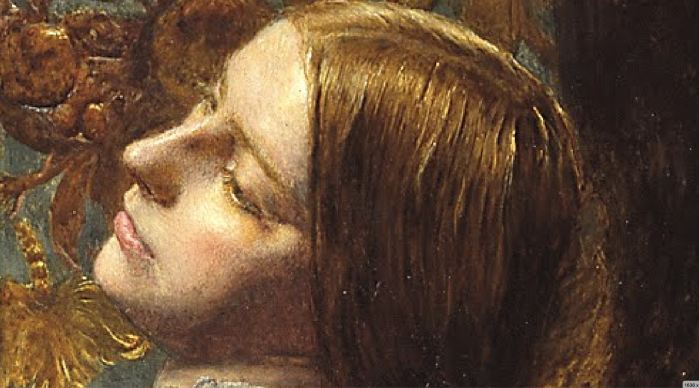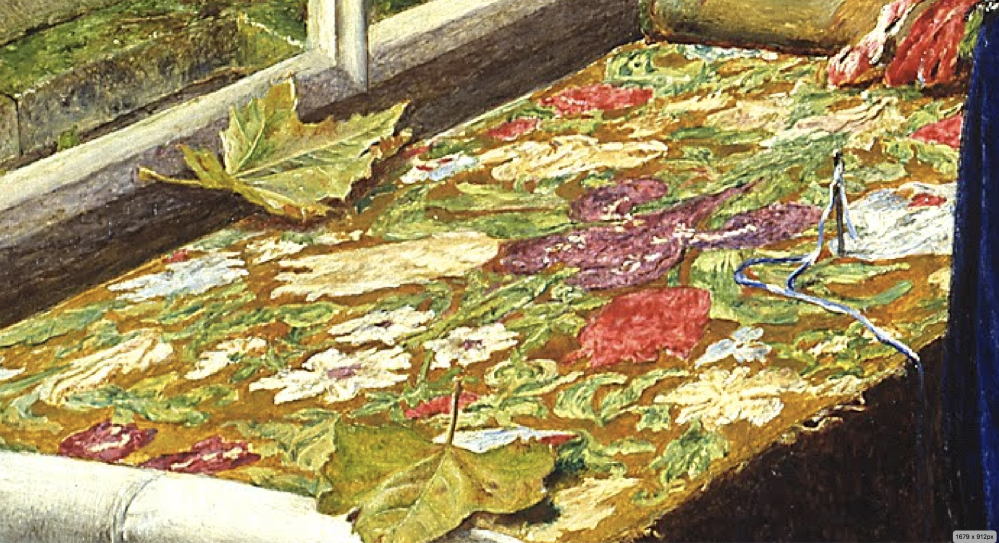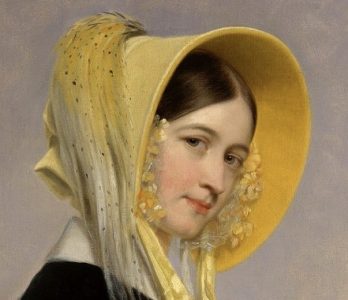
Who is John Everett Millais?
John Millais (1829–1896) was a founding member of the Pre-Raphaelite Brotherhood, a group of English artists who united in 1848 hoping to renew British painting. They idealized the sincerity of purpose and clarity of form of the early Italian Renaissance artists—before Raphael—finding art that they sought to emulate.
The Pre-Raphaelite Brotherhood often used allegorical images to create a narrative which taught a moral virtues using vibrant color, abundant detail, and complex compositions of Quattrocento Italian art.
Tennyson’s “Mariana”
According to , the painting “Mariana” is an illustration of Tennyson’s poem of the same name:

She only said, ‘My life is dreary,
He cometh not,’ she said
She said, “I am aweary, aweary,
I would that I were dead!”
Dr. Easby continues,
“The inspiration for the poem was taken from the character of Mariana in Shakespeare’s play ‘Measure for Measure’, who was locked in a moated grange…for years after her dowry was lost at sea in a storm, causing her to be rejected by her lover, Angelo. However, the happily ever after ending found in Shakespeare’s play is not even hinted at in either Tennyson’s poem or the painting by Millais.” smarthistory
Furthermore, Millais used Tennyson’s poetry to create a narrative for his painting of Mariana, and he wanted to allow the viewer familiar with Tennyson’s poetry to read the entire poem through the painting.

The Narrative Clues
According to Tate Museum, “In the picture the autumn leaves scattered on the ground mark the passage of time. Mariana has been working at some embroidery and pauses to stretch her back. Her longing for Angelo is suggested by her pose and the needle thrust fiercely into her embroidery. The stained-glass windows in front of her show the Annunciation, contrasting the Virgin’s fulfillment with Mariana’s frustration and longing.”
Dr. Rebecca Jeffrey Easby at smarthistory writes, “As is typical with the Pre-Raphaelites, Millais’ painting shows his mastery of the minute detail.” She continues:
“The viewer can almost reach out and touch the softness of her velvet dress, and the jewels in her belt glitter against the dark blue fabric.”“The beautiful stained glass windows depicting an Annunciation scene were adapted from the windows in the Chapel of Merton College, Oxford. Even the smallest details such as the small mouse that runs across the floor and the light of the lamp by the prie dieu in the corner are painted with the same attention to truth to nature found in the more prominent elements of the painting.”

In addition, Frances Fowle (Dec. 2000) explains further connections:
“The motto ‘In coelo quies’ means ‘In Heaven there is rest’ and clearly refers to Mariana’s desire to be dead.” The snowdrop symbolizes ‘consolation’ and is also the birthday flower for 20 January, St Agnes’ Eve, when young girls put herbs in their shoes and pray to St Agnes to send them a vision of their future husband. It may also refer indirectly to John Keats’s narrative poem ‘The Eve of St Agnes’, which, like Tennyson’s Mariana, is also concerned with the theme of yearning.”
The mouse in the right foreground is Tennyson’s mouse that ‘Behind the mouldering wainscot shriek’d, | Or from the crevice peer’d about’. The miniature altar in the background, decorated with a small triptych, and a silver casket, may refer to Tennyson’s other poem on the same theme, Mariana in the South, in which Mariana prays desperately to the Virgin Mary.” (Frances Fowle December 2000 at Tate Museum)
Video: “Mariana” by Millais
Mariana
By Alfred, Lord Tennyson
“Mariana in the Moated Grange”
(Shakespeare, Measure for Measure)
I would that I were dead!”

About a stone-cast from the wall
I would that I were dead!”

from Poetry Foundation
The Pre-Raphaelite Brotherhood

The Pre-Raphaelites were a secret society whose principal members were William Holman Hunt, John Everett Millais, and Dante Gabriel Rossetti.
According to Tate Museum,
“Inspired by the theories of John Ruskin, who urged artists to ‘go to nature’, they believed in an art of serious subjects treated with maximum realism. Their principal themes were initially religious, but they also used subjects from literature and poetry, particularly those dealing with love and death. They also explored modern social problems.”
The Pre-Raphaelite Brotherhood opposed two popular trends:
- the Royal Academy’s promotion of the Renaissance master Raphael.
- the immensely popular genre painting of the Victorian era. (The term genre painting refers to paintings which depict scenes of everyday life)
In the midst of the Industrial Revolution and scientific discovery, these artists looked backward and created works that celebrated a distinct Medieval aesthetic. (wikipedia)
The Victorian Ideal
writes that Millais’ Mariana is the epitome of the Victorian idea of a medieval woman. She says, “Set in a vaguely Gothic interior with pointed arches and stained glass windows, the painting has an air of mystery and melancholy that is typical in Victorian depictions of the Middle Ages.”

“The motto ‘In coelo quies’ means
‘In Heaven there is rest’ and clearly refers to
Mariana’s desire to be dead.”
Frances Fowle December 2000 at Tate Museum
In Conclusion
Millais’s painting shows Mariana from Shakespeare’s play Measure for Measure and is an illustration for Tennyson’s poem of the same name. Her loss is two-fold: both her dowry and her fiance Angelo have vanished. She is bereft and alone, but obviously still yearns for Angelo (the rat?!) and hopes that her circumstance might change.
Dr. Rebecca Jeffrey Easby at smarthistory summarizes as follows:
“In ‘Mariana’, Millais has created both an essay in Pre-Raphaelite execution and an evocative literary female portrait. The viewer feels the release of her aching muscles as she leans backward, however we are also palpably aware of her isolation. It is a work that is at once vibrant and colorful, but also cold and forbidding.“
Mariana’s posture, her intricate embroidery, the fallen leaves, and the appurtenances of the room suggest the burden she feels as each day inexplicably ends – without change. She is thus a prisoner – she cannot escape the dark melancholy of her surroundings any more than she can break free from her emotional bondage.
Click for Image Details
For More Information
About This Painting:
- This painting at the Tate
- This painting at Victorian Web
- This painting on the Google Art Project
- This painting at wikipedia
About John Everett Millais
- John Everett Millais at Victorian Web
- John Everett Millais at wikipedia
- Sir John Everett Millais, Bt at the Tate Museum, UK
About the Pre-Raphaelite Brotherhood
- Pre-Raphaelite Brotherhood at Victorian Web
- Pre-Raphaelite Brotherhood from wikipedia
- Pre-Raphaelite at the Tate Museum
References
- Dr. Rebecca Jeffrey Easby, “Sir John Everett Millais, Mariana,” in Smarthistory, August 9, 2015, https://smarthistory.org/millais-mariana/ (accessed June 10, 2018)
- Poetry Foundation, Mariana, , https://www.poetryfoundation.org/poems/45365/mariana. (accessed June 10, 2018 ).
- Frances Fowle, “Sir John Everett Millais’ Mariana”, (December 2000) Tate Museum https://www.tate.org.uk/art/artworks/millais-mariana-t07553 (accessed 24 Sept 2018).
- Wikipedia contributors, “Mariana (Millais),” Wikipedia, The Free Encyclopedia, https://en.wikipedia.org/w/index.php?title=Mariana_(Millais)&oldid=843580178 (accessed June 11, 2018).
- Wikipedia contributors, “Mariana (poem),” Wikipedia, The Free Encyclopedia, https://en.wikipedia.org/w/index.php?title=Mariana_(poem)&oldid=835815725 (accessed September 27, 2018).
Thanks for Reading! 🙂
















What a sad theme to choose.
LikeLike
Pictures don’t do justice to the actual colours.
LikeLiked by 1 person